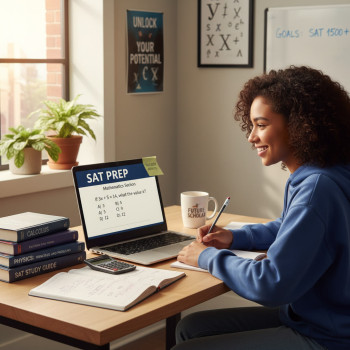Take a Breath: Why Falling Behind Isn’t the End
First things first—let’s clear the air. Falling behind on SAT prep happens to almost every student at some point. Busy schedules, extracurriculars, illness, AP tests, or just the emotional drag of senior year can derail even the best-laid plans. That moment of panic when you realize your test date is closer than you thought? Totally normal. The important thing is what you do next.
This article is a practical, human-centered guide to recovering from a lapse in Digital SAT preparation. You’ll get a clear recovery roadmap, manageable study blocks, practice strategies specific to the digital format, ways to rebuild confidence, and tips for using targeted support—like Sparkl’s personalized tutoring—if you want an efficient shortcut back on track.
Step 1: Assess Your Situation—Fast and Honest
Don’t guess. Spend one focused hour assessing where you actually are. Treat this like a diagnostic check, not a judgment session.
What to check during your hour
- Test date: How many weeks until test day? Write the exact date on a sticky note.
- Baseline: When was your last full practice test? What was your score and section breakdown?
- Strengths vs. gaps: Which question types consistently slow you down—algebra, data interpretation, command of evidence, or grammar?
- Time availability: How many hours per week can you realistically commit from now until test day?
- Tools and resources: Do you have access to Bluebook for full-length practice tests and Official SAT Practice on Khan Academy?
Write everything down. This single-hour assessment will guide the rest of your plan, and you’ll refer to it again and again.
Step 2: Set One Realistic Target—Your Guiding Star
Instead of vague goals like “get better,” pick one concrete target: a score range or the most urgent skill to fix. Keep it ambitious but reachable. For example:
- Raise Math by 40 points in 8 weeks.
- Get comfortable with adaptive format and finish 75% of practice sections on time.
- Increase evidence-based reading speed to answer main idea and command-of-evidence questions in two minutes each.
Why one target? Because when you’re recovering, focusing your energy yields faster, measurable wins. Once you hit that target, pick the next one.
Step 3: Build a Practical Catch-Up Schedule
Now translate your available hours into a weekly schedule. Consistency beats marathon sessions. Even short, daily habits add up faster than sporadic cramming.
A sample 6-week catch-up schedule (for 8–12 hours/week)
| Week | Focus | Weekly Plan | Outcome Goal |
|---|---|---|---|
| 1 | Diagnostic + fundamentals | 1 full Bluebook practice test; 3 targeted skill sessions (45–60 min each); 2 quick drills (20 min) | Identify top 3 weak areas and familiarize with tools |
| 2 | Targeted practice | 4 skill sessions (60 min); 1 timed section practice; 1 review day | Begin closing weakest gap (e.g., algebra or command of evidence) |
| 3 | Pacing & digital tools | 3 timed section practices; 2 skill sessions; 1 full practice test | Improve pace and comfort using Bluebook features |
| 4 | Mixed practice | 1 full test; 3 mixed-section timed practices; 2 review sessions | Start to see score improvements and reduced careless errors |
| 5 | Polish and stamina | 1 full test; daily short drills; focus on weaker question types | Consistency in timing and accuracy across sections |
| 6 | Final prep & strategy | 2 full tests spaced out; light review; rest and mindset work | Confidence and test-day routine locked in |
This is a template—customize it to your test date and available time. If you only have 3–4 weeks, compress the same ideas but prioritize timed sections and practice tests.
Step 4: Prioritize High-Impact Activities
When you’re short on time, do these first. They pack the biggest payoff per hour.
- Full-length Bluebook practice tests under test conditions (timed, same device if possible).
- Targeted question banks for your weakest topics—do 20–30 focused problems, then review answers carefully.
- Timed section practice to build pacing skills for the digital format.
- Error log: record each missed question, why you missed it, and what you’ll do differently next time.
- Official lessons on Khan Academy to reinforce skills found in your error log.
Why Bluebook and Official SAT Practice on Khan Academy?
The Digital SAT uses adaptive testing and specific tools—practice in the same environment helps you avoid surprises. Official practice tests in Bluebook and personalized practice plans on Khan Academy are designed for that exact purpose, so prioritize them when you’re recovering from a setback.
Step 5: Make Practice Tests Work for You (Not Just a Score)
Practice tests are diagnostic gold when used properly. Don’t treat them as a one-off measurement. Use them as cycles of improvement.
After each practice test
- Grade quickly and record section scores.
- Fill your error log with every missed question categorized by type and reason (content gap, careless mistake, time pressure, misunderstanding the question).
- Identify 2–3 lesson objectives for the next week based on repeated error types.
- Simulate test-day conditions: no phone, same breaks, same device settings (Bluebook prep features).
Repeat this cycle: practice test → deep review → targeted practice → another practice test. Each cycle should feel shorter and more focused than the last.
Step 6: Short, Targeted Drills Beat Long, Aimless Sessions
When you’re behind, efficiency matters. Use short drills to build muscle memory and speed.
- 15–30 minute arithmetic and algebra drills for math fluency.
- 20-minute passage drills: practice finding main ideas and evidence quickly.
- 10-minute grammar spot checks: common sentence-structure rules and punctuation traps.
- Timing drills: full 25-minute digital reading section or 45-minute math section practice depending on the format length you’re using in Bluebook.
Step 7: Rebuild Confidence with Quick Wins
Falling behind often hurts confidence more than competence. Stack small wins to rebuild momentum:
- Master one tricky concept this week and celebrate it—factorization, conditional probability, or command-of-evidence questions.
- Reduce careless errors on one practice section—count how many mistakes are careless vs. conceptual.
- Beat your previous timed section pace even if accuracy stays the same.
Confidence is cumulative. Those small victories create real changes in how you approach harder problems.
Step 8: Use Smart Review—Not Just Repetition
Avoid passive review. Active review is structured and deliberate: explain your reasoning, re-solve problems without looking, and teach concepts out loud (even if it’s to a stuffed animal).
Active review techniques
- Self-explanation: After solving a problem, explain every step in one clear sentence.
- Error categorization: Put errors into “careless,” “strategy,” or “content” buckets—and treat each differently.
- Spaced repetition: revisit a weak concept every few days, increasing intervals between reviews as you improve.
Step 9: Tactics for the Digital Test Format
The Digital SAT isn’t just paper in disguise. Its adaptive nature and on-screen tools change how you should practice.
- Familiarize yourself with the digital tools (highlighting, flagging, passage map) in Bluebook—practice using them until they feel natural.
- Practice adaptive thinking: answer carefully rather than guessing wildly; early performance can alter later difficulty.
- Use on-screen annotation to manage long math setups and evidence-based reading markers to track where answers live in a passage.
Practicing in the exact digital environment reduces test-day friction and improves stamina for screen-based reading and problem solving.
Step 10: When to Get Extra Help (and How to Choose It)
There’s a smart line between independent recovery and asking for help. If you’ve tried focused practice for 2–3 weeks and don’t see progress in your weak areas—or you need faster improvement—consider personalized support.
Benefits of personalized tutoring you should look for:
- 1‑on‑1 guidance to diagnose subtle misconceptions.
- Tailored study plans that match your exact weaknesses and test date.
- Expert tutors who can model problem-solving strategies quickly and provide accountability.
- AI-driven insights or progress tracking to show where your hours have the most impact.
For many students, Sparkl’s personalized tutoring fits naturally into this recovery process—offering 1‑on‑1 guidance, tailored study plans, expert tutors, and AI-driven insights to accelerate catch-up work. If structured support feels right, look for a program that customizes content to your results from Bluebook practice tests and error logs.
Step 11: Test-Day Logistics and Mindset
Don’t let logistics sabotage your comeback. Make test day as frictionless as possible:
- Install and practice on the Bluebook app well before test day; confirm device compatibility and any settings you need.
- Do a dress rehearsal: attempt a full practice test at the same time of day as your actual test and with the same breaks.
- Prepare a simple routine the night before: sleep, light review (no new content), and a calm morning ritual.
- On test day, start with a brief mindfulness or breathing exercise to reduce anxiety—three slow breaths can reset focus.
Step 12: Track Progress with Meaningful Metrics
Don’t over-focus on one number. Instead, track multiple metrics to see real improvement:
- Practice test composite score and section scores.
- Percent of questions correct by content type (e.g., algebra, geometry, command of evidence).
- Average time spent per question type and per passage.
- Number of careless vs. conceptual errors per test.
These metrics tell you whether your time investment is shifting root causes, not just symptoms. If you’re working with a tutor or a program like Sparkl, they can help convert your practice data into a focused improvement plan and show which activities yield the highest return on time.
Common Roadblocks and How to Beat Them
Roadblock: Procrastination and guilt
Solution: Replace guilt with a single small next step—open Bluebook, run a 20-minute drill, or schedule a 30-minute session. Momentum follows action.
Roadblock: Running out of time before the test
Solution: Prioritize timing drills and mixed-section practice. Even if you can’t fix every content gap, reducing time pressure often yields immediate score gains.
Roadblock: Overwhelm from too many resources
Solution: Use a primary official resource (Bluebook + Khan Academy) and one supplemental tool. Keep it simple.
Roadblock: Test anxiety
Solution: Add short mindfulness or visualization sessions to your routine, practice under realistic conditions, and rehearse coping strategies for the most stressful moments.
Practical Examples: Catch-Up Plans for Different Time Horizons
4 weeks until test day (intensive)
- Week 1: Full diagnostic test + 4 targeted skill days.
- Week 2: Timed sections daily + error log review + one full test.
- Week 3: Focused content repair (top 2 topics) + 2 full tests.
- Week 4: Taper and polish: 1 full test early, light review, rest and routine.
8 weeks until test day (balanced)
- Weeks 1–2: Diagnostics + fundamentals + 2 full tests (one per week).
- Weeks 3–5: Deep skill work + timed sections and targeted drills.
- Weeks 6–7: Mixed practice + 2–3 full tests.
- Week 8: Final polish, pacing, and mental prep.
12+ weeks until test day (comprehensive)
- Spread the intensive actions above with more spaced repetition, concept mastery, and consistent full-length practice every 10–14 days.
- Consider integrating occasional 1‑on‑1 tutoring sessions to optimize efficiency and correct misunderstandings early.
When a Tutor Can Make the Biggest Difference
Tutors help most when your time is limited, or your errors aren’t obvious. Good tutors do three things quickly:
- Pinpoint hidden misconceptions that waste study time.
- Create a laser-focused study plan based on your Bluebook results.
- Provide accountability and real-time strategy modeling.
If you’re juggling classes and life, a few targeted sessions with an expert—especially through personalized programs like Sparkl that combine human tutoring with AI-driven insights—can multiply the effectiveness of every hour you study.
Mindset Matters: Reframing Setbacks as Data
Think of falling behind not as failure but as data. It tells you where your schedule or strategies weren’t aligned with your priorities. Use that data. Learn. Adapt. Move forward. That mindset shift is what separates students who panic from students who recover and improve.
Final Checklist: The Last Week Before Test Day
- Two full practice tests in realistic conditions, the last one 3–5 days before test day.
- Light review of your error log—no heavy new content.
- Confirm Bluebook is installed and up to date; charge your device and bring any allowed accessories to test center if required.
- Plan your morning routine: breakfast, arrival time, and a brief calming practice.
- Sleep. Prioritize rest over last-minute cramming—clarity beats memorized facts under stress.
Parting Thoughts: You Can Recover—One Smart Step at a Time
Recovering from a lapse in SAT prep is entirely doable. The playbook is simple: assess honestly, pick one target, practice deliberately with official tools, track meaningful metrics, and get focused help when you need it. Even a few weeks of disciplined, smart practice can produce big gains.
If you want help making an efficient, individualized recovery plan, consider adding a few focused tutoring sessions—Sparkl’s personalized tutoring, with 1‑on‑1 guidance, tailored study plans, expert tutors, and AI-driven insights, can accelerate your progress and help you prioritize the right work so every hour matters.
Above all, be kind to yourself. Comebacks are rarely linear. They’re built from tiny, consistent steps that show up over time. Start with one focused hour today, and you’ll be surprised at the momentum you can build by tomorrow.
Good luck—breathe, plan, practice, and believe. You’ve got this.















No Comments
Leave a comment Cancel